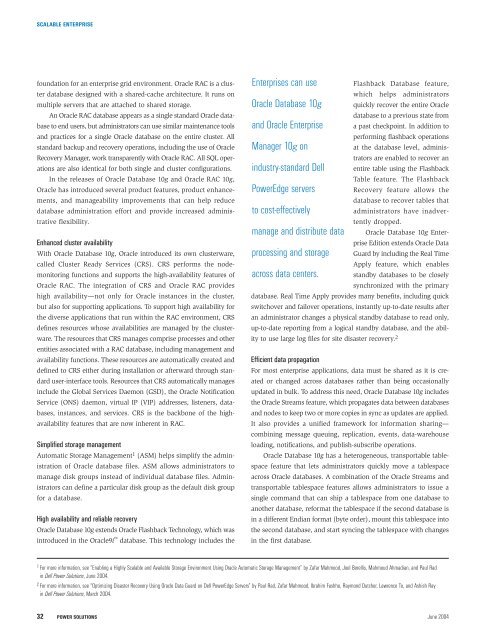Dell Power Solutions
Dell Power Solutions
Dell Power Solutions
- No tags were found...
Create successful ePaper yourself
Turn your PDF publications into a flip-book with our unique Google optimized e-Paper software.
SCALABLE ENTERPRISEfoundation for an enterprise grid environment. Oracle RAC is a clusterdatabase designed with a shared-cache architecture. It runs onmultiple servers that are attached to shared storage.An Oracle RAC database appears as a single standard Oracle databaseto end users, but administrators can use similar maintenance toolsand practices for a single Oracle database on the entire cluster. Allstandard backup and recovery operations, including the use of OracleRecovery Manager, work transparently with Oracle RAC. All SQL operationsare also identical for both single and cluster configurations.In the releases of Oracle Database 10g and Oracle RAC 10g,Oracle has introduced several product features, product enhancements,and manageability improvements that can help reducedatabase administration effort and provide increased administrativeflexibility.Enhanced cluster availabilityWith Oracle Database 10g, Oracle introduced its own clusterware,called Cluster Ready Services (CRS). CRS performs the nodemonitoringfunctions and supports the high-availability features ofOracle RAC. The integration of CRS and Oracle RAC provideshigh availability—not only for Oracle instances in the cluster,but also for supporting applications. To support high availability forthe diverse applications that run within the RAC environment, CRSdefines resources whose availabilities are managed by the clusterware.The resources that CRS manages comprise processes and otherentities associated with a RAC database, including management andavailability functions. These resources are automatically created anddefined to CRS either during installation or afterward through standarduser-interface tools. Resources that CRS automatically managesinclude the Global Services Daemon (GSD), the Oracle NotificationService (ONS) daemon, virtual IP (VIP) addresses, listeners, databases,instances, and services. CRS is the backbone of the highavailabilityfeatures that are now inherent in RAC.Simplified storage managementAutomatic Storage Management 1 (ASM) helps simplify the administrationof Oracle database files. ASM allows administrators tomanage disk groups instead of individual database files. Administratorscan define a particular disk group as the default disk groupfor a database.High availability and reliable recoveryOracle Database 10g extends Oracle Flashback Technology, which wasintroduced in the Oracle9i database. This technology includes theEnterprises can useOracle Database 10gand Oracle EnterpriseManager 10g onindustry-standard <strong>Dell</strong><strong>Power</strong>Edge serversto cost-effectivelymanage and distribute dataprocessing and storageacross data centers.Flashback Database feature,which helps administratorsquickly recover the entire Oracledatabase to a previous state froma past checkpoint. In addition toperforming flashback operationsat the database level, administratorsare enabled to recover anentire table using the FlashbackTable feature. The FlashbackRecovery feature allows thedatabase to recover tables thatadministrators have inadvertentlydropped.Oracle Database 10g EnterpriseEdition extends Oracle DataGuard by including the Real TimeApply feature, which enablesstandby databases to be closelysynchronized with the primarydatabase. Real Time Apply provides many benefits, including quickswitchover and failover operations, instantly up-to-date results afteran administrator changes a physical standby database to read only,up-to-date reporting from a logical standby database, and the abilityto use large log files for site disaster recovery. 2Efficient data propagationFor most enterprise applications, data must be shared as it is createdor changed across databases rather than being occasionallyupdated in bulk. To address this need, Oracle Database 10g includesthe Oracle Streams feature, which propagates data between databasesand nodes to keep two or more copies in sync as updates are applied.It also provides a unified framework for information sharing—combining message queuing, replication, events, data-warehouseloading, notifications, and publish-subscribe operations.Oracle Database 10g has a heterogeneous, transportable tablespacefeature that lets administrators quickly move a tablespaceacross Oracle databases. A combination of the Oracle Streams andtransportable tablespace features allows administrators to issue asingle command that can ship a tablespace from one database toanother database, reformat the tablespace if the second database isin a different Endian format (byte order), mount this tablespace intothe second database, and start syncing the tablespace with changesin the first database.1 For more information, see “Enabling a Highly Scalable and Available Storage Environment Using Oracle Automatic Storage Management” by Zafar Mahmood, Joel Borellis, Mahmoud Ahmadian, and Paul Radin <strong>Dell</strong> <strong>Power</strong> <strong>Solutions</strong>, June 2004.2 For more information, see “Optimizing Disaster Recovery Using Oracle Data Guard on <strong>Dell</strong> <strong>Power</strong>Edge Servers” by Paul Rad, Zafar Mahmood, Ibrahim Fashho, Raymond Dutcher, Lawrence To, and Ashish Rayin <strong>Dell</strong> <strong>Power</strong> <strong>Solutions</strong>, March 2004.32POWER SOLUTIONS June 2004








